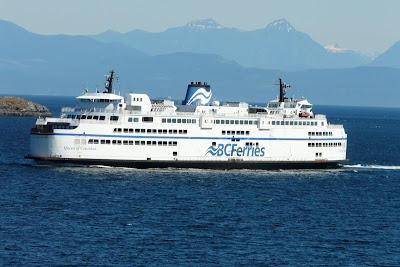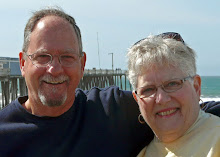The second day we drove through very rugged mountains and as the day progressed they became more rounded and we then we traveled through farm lands with produce growing all over and many vineyards. The road was very windy and quite hilly also. We ended our travels for the day in the Okanagan Valley at Desert Gem R.V. Resort in Oliver, B.C. known as the Wine Capital of Canada.
The third day’s drive was through very pretty mountains, not as curvy and hilly as yesterday; making it much more relaxing. The road we were on followed rivers, lakeshores, climbed through several very scenic mountain passes and some tiny towns.
We arrived in Nelson, B.C. which is on the west arm of Kootenay Lake, reigning as the premier small arts town in Canada. Baker Street, which we walked from one end to the other overflows with galleries, shops, open-air restaurants, coffee shops, street musicians and an active night life. It is very eclectic here. We were fascinated by the dress of the young adults. We enjoyed dinner at Jackson’s Hole and Grill where Roxanne, the 1986 movie starring Steve Martin and Daryl Hannah was filmed. The building was the fictitious Dixie’s Café.
The next day our destination was the Silvery Slocan Side Trip, a 135 mile loop through the mountains in the Selkirk area. The scenery was spectacular and there is a lot of history here. Starting from Nelson we went through many very small towns including Slocan Park, Winlaw, Slocan, Silverton, New Denver, Sandon, Kaslo, Ainsworth Hot Springs, and Balfour. In Kaslo we saw the world’s oldest intact passenger sternwheeler, the Moyie. It was launched at Nelson in 1898 and steamed on Kootenay Lake until 1957. The boat logged almost a million miles carrying generations of miners, settlers, business and excursion crowds. She also carried soldiers in both wars and became woven into the fabric of everyday Kootenay life.
Silver mining was done in this area and we saw lots of old machinery in Sandon, which is where we enjoyed our picnic lunch by the running river. This is a ghost town today and was once a thriving mining city of 5,000.
In New Denver we went to the Nikkei Internment Memorial Centre. This is the only site in Canada dedicated to telling the story of this infamous chapter of World War II history. In 1942 about 22,000 people of Japanese descent, 75% of whom were Canadian citizens, were stripped of their civil rights, labeled ‘enemy aliens’ and forced from their coastal BC homes. The federal government ordered men to road camps. Families assembled in Vancouver’s Hastings Park were placed in animal stalls awaiting removal to interior BC ‘relocation’ camps or sugar beet farms in Alberta, Manitoba and Ontario. In 1988 these people were issued an official apology and promised a token monetary compensation for property losses suffered at the time. They have many of the original structures, lots of pictures and artifacts housed here. This is like what happened in Manzanar in California, south of Tahoe except in California they don’t have any buildings or items, just the remains of foundations in the ground of some of the building!
We then headed to see a gorgeous Japanese Garden and enjoyed walking around it. The grounds were magnificent. We spent about seven hours on this informative side trip.




































No comments:
Post a Comment